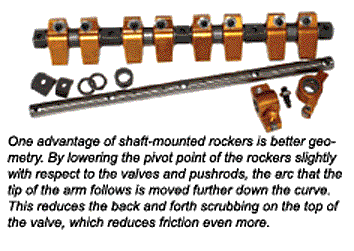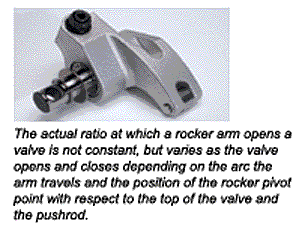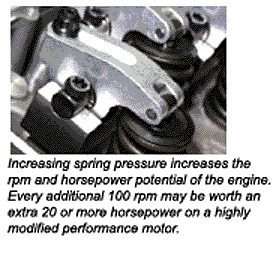On a small block Chevy, altering the rocker arm geometry without changing the rocker arm lift ratio can add 15 to 20 horsepower at the rear wheels.
The stock lift ratio for a small block (SB) Chevy V8 rocker arm is 1.5:1, and for a big block (BB) Chevy V8, the ratio is 1.7:1. Bolt-on aftermarket high lift rocker arms with higher ratios are often used to get more net lift out of an existing cam profile. The most common high lift ratio upgrade for a SB Chevy engine is 1.6:1 rocker arms, and 1.8:1 rockers for BB Chevys. But some performance rockers now offer ratios as high as 2.0:1 or even higher!
Increasing the lift ratio adds horsepower with little or no loss in low rpm torque, idle quality or vacuum. By opening and closing the valves at a faster rate, the engine flows more air for the same number of degrees of valve duration. High lift rocker arms also reduce the amount of lifter travel needed to open the valves, which reduces friction and the inertia of the lifters and pushrods that must be overcome by the valve springs to close the valves. On the other hand, increasing the rocker ratio also increases the effort required to open the valves because of the leverage effect. The higher the rocker arm ratio, the greater the force the camshaft, lifters and pushrods have to exert to push the valves open. But when the valves close, the increased leverage of the rocker arms works the other way making it easier for the springs to shut the valves and push the rocker arms, pushrods and lifters back to their rest positions.
On SB Chevy engines, the stock stud-mounted rocker arms are supposed to be self-centering and self-aligning. The ball pivot inside the stamped steel rocker arm allows the tip of the rocker arm to follow the top of the valve as the valve is pushed open. This creates some back and forth scrubbing friction between the tip of the rocker arm and the top of the valve. And the higher the valve lift and the stiffer the springs, the greater the friction. Over time, this can cause side wear in the valve guides, tip wear on the end of the valve stems, and worn rocker arms.
Aftermarket performance rocker arms, whether they are stamped steel, stainless steel, or diecast, extruded or machined aluminum, usually have a roller tip to reduce friction between the rocker arm and valve. The roller, in theory, rolls back and forth on the top of the valve stem to reduce friction, wear and side forces exerted against the valve. Most stud-mounted aluminum rocker arms also have a needle bearing fulcrum to further reduce friction at the pivot point, and a hardened steel insert in the short end of the arm to accommodate the pushrod. Power gains of 15 to 30 horsepower are often claimed for aftermarket rocker arms even with stock ratios because of reduced friction. Aftermarket performance rocker arms are also stronger than stock stamped steel rocker arms, and provide improved reliability and longevity. But stud-mounted rockers have certain limitations.
One is that they often require pushrod guide plates to help keep everything in proper alignment, especially at high rpms and spring loads. Another limitation is that they can’t handle valvetrain misalignment very well. If the rocker arm twists, it may bend the pushrod and/or allow the tip of the rocker arm to walk off the side the valve tip. If that happens, the rocker may push down on the retainer instead of the valve, causing the locks to pop out and the valve to disappear down the guide, destroying the engine.

SHAFT MOUNTED ROCKERS
The hot setup today is shaft-mounted rocker arms. Shaft mounted rockers would seem to be a throwback to the days before the first stud-mounted stamped steel rocker arms appeared on small block Chevy V8s in 1955. One of the features that made the SB Chevy such a performer was its lightweight, high revving valvetrain. But keep in mind, that was a time when maximum engine speeds were in the 6,500 to 7,000 rpm range, not 8,500 to 9,000 rpm or higher, and most engines were running single springs, not double or even triple springs.
Shaft mounted rockers have a number of advantages. One is better alignment. The shaft is rigid so the rockers are held in perfect alignment. This eliminates the need for separate pushrod guide plates while also limiting valve train deflection. At high rpm, pushrods and rocker arm studs can flex quite a bit, and the more they deflect the more it hurts valve lift, duration and valve control. This costs horsepower and can be seen on a dyno. So the more rigid the valvetrain, the less the valve flutter at high rpm.
Shaft mounted rocker arms also provide extra strength and support, eliminating the need for a separate stud girdle. Aluminum stud girdles are often necessary to reinforce the valvetrain when a high lift cam (or rockers) and stiff springs are used. The girdle clamps around the studs and ties them together to reduce stud flex and the risk of breakage. But the girdle also makes it harder to adjust the valves. Shaft mounted rocker arms don’t have that issue because the adjusters are on the arms, not the studs, and are easily accessible.
Mounting the rocker arms on a rigid shaft also eliminates the "jack hammer" effect that occurs with stud-mounted rockers. Every time the valve opens and closes, the change in valve lash that occurs with a solid lifter cam causes a stud-mounted rocker arm to slide up and down on its stud. This hammering effect can pull a pressed-in stud out of the cylinder head, and may cause fatigue failure in a screw-in stud or the rocker arm.
Another advantage of shaft-mounted rockers is better geometry. By lowering the pivot point of the rockers slightly with respect to the valves and pushrods, the arc that the tip of the arm follows is moved further down the curve. This reduces the back and forth scrubbing on the top of the valve, which reduces friction even more. One supplier of shaft-mounted rockers says this change alone reduces the torque it takes to turn a SB Chevy over by 80 ft. lbs, and is good for 15 to 20 horsepower.
Lubrication can also be an advantage with shaft-mounted rockers. Some have internal oil passages that route pressurized oil directly to the rocker arms and/or valve springs instead of relying on splash lubrication from oil squirting up through the pushrods.
Shaft mounted rockers are available from a number of aftermarket suppliers, and fit not only stock SB Chevy and Ford heads but also most of the popular aftermarket heads made by Brodix, World, Edelbrock and others. The shaft-mounted rockers typically sell in the $700 to $900 range and are an excellent upgrade for any performance engine.

Another supplier of aftermarket rocker arms has taken a similar approach by redesigning some of their stud-mounted rocker arms for the LS1 Chevy. The rocker arms require milling the stud pads on the cylinder heads .170" to accommodate the lowered rockers, but the net result is better geometry, less side wear on the valves and faster initial opening that produces more horsepower.
What you may not know is that the actual ratio at which a rocker arm opens a valve is not constant, but varies as the valve opens and closes depending on the arc the arm travels and the position of the rocker pivot point with respect to the top of the valve and the pushrod. The stock LS1 rockers are mounted rather high and initially open the valve at a rate equivalent to about 1.54 to 1 before eventually reaching 1.7:1. The quick lifting aftermarket rocker arms, by comparison, lift the valve off the seat at a ratio that is closer to 1.8 to 1 and then goes to 1.7 to 1 at .200" valve lift. This has the same effect as increasing valve duration about six degrees, and produces 15 to 18 more horsepower.
INTERFERENCE ISSUES
As the ratio of the rocker arms goes up, the net lift of the valves increase and the valve springs are compressed much closer together. Clearances must be checked to avoid coil bind and contact between the bottom of the valve retainer and top of the valve guide. Springs should have a safety margin of .060" of remaining travel at maximum valve lift to avoid coil bind. The minimum clearance between the retainer and valve guide at maximum valve lift should also be .060". If the minimum clearances are not maintained and the valve spring or retainer bottoms out, the valvetrain will usually bend or break a pushrod. Clearance between the rocker arm and spring retainer must also be checked at maximum lift to make sure they don’t touch. The stock rockers on a SB Chevy V8 can handle about .470" of valve lift. More lift requires switching to "long slot" rockers or aftermarket rockers with extra clearance.
High lift aftermarket rocker arms or a high lift cam may require using different springs that allow increased spring travel. Some springs cannot handle a maximum valve lift of more than .550". For higher lifts, different springs are required. Follow the spring supplier’s recommendations when matching valve springs to maximum valve lift.
Another way to avoid spring bind is to raise the installed height of the valve or to lower the spring seat. But both of these will reduce spring tension, which is not the way to go with a high revving engine.
For small block street performance engines with a flat tappet cam and no more than .450" of lift, single springs with 80 to 90 lbs. of seat pressure with the valves closed are usually adequate. For street/strip performance engines, springs with 100 to 120 lbs. of seat pressure are usually recommended. For street hydraulic roller cams, seat pressure should typically be 105 to 140 lbs., and should not exceed a maximum of 150 lbs. with a mechanical roller cam.
Double or even triple springs are usually required to achieve higher spring pressures. Seat pressures for double springs typically range from 130 to 150 lbs. or higher, and 300 or more lbs. for triple springs. Most NASCAR teams run dual springs with seat pressures of 190 to 200 lbs. and open pressures of 500 to 600 lbs. at .750" lift. Pro Stock drag racers, by comparison, typically run triple springs with seat pressures of 375 to 475 lbs. with the valves closed, and up to 1,000 lbs. open!
Increasing spring pressure increases the rpm and horsepower potential of the engine. Every additional 100 rpm may be worth an extra 20 or more horsepower on a highly modified performance motor. The current limit for steel valve springs is about 83 to 85 cycles per second, or about 10,000 rpm. NASCAR teams run a 200 to 400 mile race at 8,500 to 9,000 rpm. But drag racers only run a quarter of a mile.
High pressure valve springs can deliver the rpms, but there’s a price to be paid because the springs don’t last. Running at such high rpm wears out the springs. Consequently, the springs have to be replaced fairly often (every race with NASCAR engines, and after so many runs with drag racers).
Higher spring pressures also puts more load on the rocker arms, pushrods, lifters and cam lobes, which increases the risk of something breaking.
According to one major camshaft supplier, standard camshafts can usually handle open valve spring pressures of up to 550 lbs. But for higher spring pressures, a carburized 8620 or 9310 steel camshaft is required.
Installing double springs may require the following modifications:
Flycutting the spring seats in the heads to accept the springs.
Changing the spring retainers to ones that are designed for double or triple springs.
Changing the valve seals and/or machining the guides for extra clearance.
Replacing pressed-in rocker arm studs with screw-in studs and a stud girdle, or installing shaft-mounted rocker arms.
Replacing the stock pushrods with stronger and stiffer 4130 chrome moly pushrods (to prevent pushrod flexing and breakage).
If the springs provide more than 350 lbs. of pressure when the valves are open, the stock stamped steel rockers will have to be replaced with stronger aftermarket steel or aluminum rockers.

BEEHIVE SPRINGS
Beehive springs that taper towards the top are a hot commodity in the aftermarket, but date back to the earliest days of the automobile. Like shaft-mounted rockers, though, they are finding new applications in todays high performance engines. Chevy LS1/LS7 series engines use a factory beehive spring, as do Ford modular 4.6L V8s. Similar spring designs have been developed for SB Chevy and Ford engines by aftermarket suppliers.
Unlike a conventional valve spring that has a constant diameter, a beehive spring tapers in toward the top sort of like a real beehive (thus the name). A smaller top means a smaller and lighter valve spring retainer can be used to reduce weight. Also, the change in the diameter of the spring as it tapers toward the top creates a progressive spring rate that helps the spring resist harmonics that occur in conventional constant rate springs. The bottom line is that beehive springs perform better than conventional single springs on many (but not all) engine applications.
One spring supplier said their beehive springs can increase the rpm potential of an engine 100 to 1,200 rpm depending on the cam, valvetrain and other engine modifications. The maximum amount of valve lift a beehive spring can handle is about .650", so if the engine needs more lift it will require dual or triple springs.
Beehive springs have been popular on the street, but some racers are cautious about using them because there’s no safety margin if a spring breaks. With a double or triple spring, the engine won’t eat a valve if a spring breaks. The extra springs serve as a backup to pull the valve shut.
SPRING COATINGS
Heat is the main enemy of the springs, with dual and triple springs typically generating more heat than single springs because they rub against each other. Managing heat, therefore, is critical for spring longevity.
The durability of a spring depends on the quality and purity of the alloy that is used to manufacture the spring, the heat treatment the spring receives, and any additional surface treatments the spring is given. Some springs are nitrited while others are coated with proprietary chemicals that help the spring run cooler. Another trick that can extend spring life is to have the springs cryogenically treated. Freezing the springs to 300 degrees below zero can increase spring life up to five-fold, according to those who do it.
SPRING INSTALLATION
There are a couple of things to watch when installing valve springs. One is height. This ensures the springs have the required pressure to keep the valves shut. Height is checked by measuring the distance between the spring seat in the head and the retainer on the valve stem. Most performance valve springs are closely matched, but if adjustments are needed it can be done by shimming the valves to equalize pressures. The thicker the shim, the more it increases spring pressure. Don’t overshim, though, because doing so may lead to coil bind with a high lift cam or rocker arms.
Shims are made of hardened steel, come in various thicknesses and are usually serrated on one side to prevent rotation (the serrated side faces the head). Some shims are also designed to help insulate the springs from heat generated by the cylinder head.
Springs should also be lubricated when they are installed in a new engine, especially double and triple springs, to reduce friction. Soaking the springs in oil or coating them with assembly lube should provide adequate protection during the critical first start-up.
VALVE SPRING RETAINERS & LOCKS
Reducing weight on the valve side of the rocker arm has more of an impact than reducing weight on the pushrod side because of the leverage effect. Lightweight valve retainers made of titanium have long been the preferred upgrade here. But in the past year, the price of titanium has skyrocketed. Most of the world’s titanium supply comes from Russia and is being consumed by China. Some aftermarket suppliers have responded to the changing market conditions by introducing new lightweight steel retainers.
For street applications, steel retainers with stock 7 degree locks are usually recommended. But for racing or high rpm roller cams, titanium retainers with 7 or 10 degree locks can reduce weight. Some locks have an extra step inside that reinforces the bottom of the retainer and reduces the risk of the valve pulling through at high rpm.
When the valve locks are installed around the valve stem, their edges must not touch each other. They should clamp against the valve stem and hold it securely. Keep in mind that the design of the retainer affects the installed valve height and spring tension.













